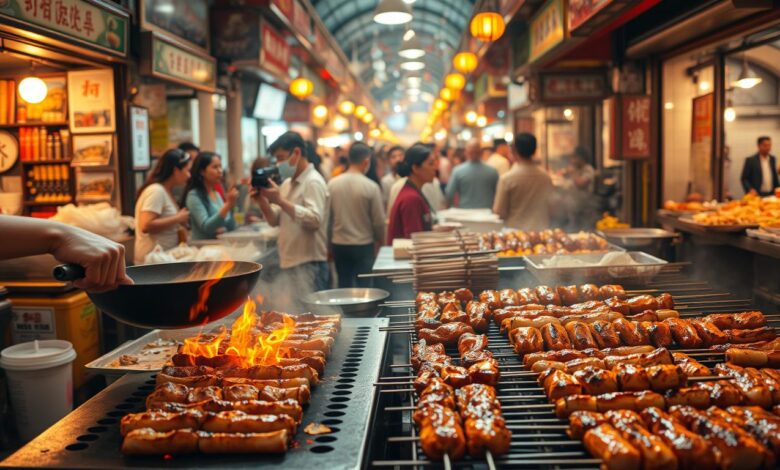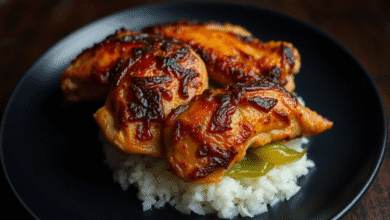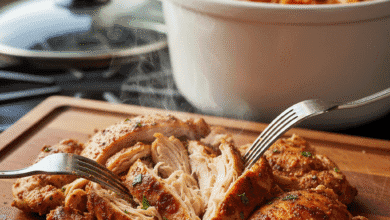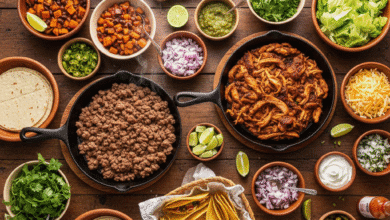Asian Street Meats: 5 Unique Cooking Techniques That Define Flavor

What makes street food so irresistible? You might have savored the bold and aromatic flavors of Asian cuisine while walking through a bustling market.

The world of street food is diverse and rich in flavors. Various regions offer their unique twists. As you explore the realm of Asian street meats, you’ll discover the techniques that make these dishes stand out.
This article will take you on a journey through 5 unique cooking techniques. These techniques define the flavor of these popular dishes. They give you a deeper understanding of the culinary art that goes into creating them.
Table of Contents
The Vibrant World of Asian Street Meats
Street food in Asia is more than a meal; it’s an experience. It combines flavor, culture, and community. The vibrant world of Asian street meats shows the region’s rich culinary diversity.
The Cultural Significance of Street Food in Asia
Street food is deeply ingrained in Asian cultures. It’s a communal activity that brings people together. In cities and towns across Asia, street food vendors are a common sight.
They offer a wide range of dishes that reflect local tastes and traditions. The cultural significance of street food can be seen in its ability to transcend socioeconomic boundaries. It provides affordable and delicious meals for people from all walks of life.
| Cultural Aspect | Description | Example |
|---|---|---|
| Community Building | Street food vendors often become gathering points for locals. | Night markets in Taiwan |
| Culinary Tradition | Street food reflects local culinary practices and ingredients. | Satay in Southeast Asia |
| Economic Accessibility | Street food is generally affordable, making it accessible to a wide audience. | Street stalls in India |
Why These Cooking Methods Create Unforgettable Flavors
The cooking methods used in Asian street food are crucial. Techniques like grilling, frying, and steaming bring out the unique characteristics of each ingredient. This is what makes the flavors so distinctive.
High-heat cooking methods achieve a perfect balance of texture and flavor. The use of aromatic ingredients and spices further enhances the flavor profile of street foods.
Essential Equipment for Authentic Asian Street Cooking
To make authentic Asian street food at home, you need the right tools. The good news is you don’t have to spend a lot to start.
Traditional vs. Modern Cooking Tools
Traditional Asian cooking uses special tools like woks, claypots, and skewers. But, modern tools can be just as good without the high cost. For example, a carbon steel wok can get hot enough for stir-fries. A claypot is great for slow-cooking dishes.
Budget-Friendly Alternatives for Home Cooks
You don’t have to buy expensive gear to cook Asian dishes. Look for cheaper options like cast-iron skillets or stainless steel pots. They work well for street food recipes. Try shopping at Asian markets or online for deals.
Key Ingredients That Define Asian Street Meats
Exploring Asian street meats reveals the secret to their delicious flavors. The variety of Asian cuisine is seen in the different ingredients used across regions.
Regional Spice Profiles
Street food is known for its unique spice profiles. Korean street food uses bold gochugaru (Korean chili flakes). Thai street food, on the other hand, features fresh lemongrass and galangal.
Spices add flavor and define the identity of Asian cuisine. Food vendors often have secret spice blends perfected over years.
Must-Have Sauces and Condiments
Sauces and condiments are key in street food. They add depth and complexity. Fish sauce, soy sauce, and oyster sauce are used to enhance umami flavors.
Coconut milk is crucial in Southeast Asian dishes. It adds richness and creaminess. Thai curries and Indonesian satay use it for a smooth texture.
| Sauce/Condiment | Common Use | Regional Preference |
|---|---|---|
| Fish Sauce | Marinades and dipping sauces | Southeast Asia |
| Soy Sauce | Marinades and stir-fries | East Asia |
| Coconut Milk | Curries and sauces | Southeast Asia |
Protein Selection Tips
Choosing the right protein is key for Asian-style street meats. Chicken, pork, beef, and lamb are popular, based on regional preferences and availability.
For popular food vendors, protein quality is crucial. Freshness and tenderness are essential for flavorful dishes that attract customers.
“The quality of your ingredients will directly impact the flavor and authenticity of your dishes. Choose fresh, high-quality proteins and ingredients to elevate your cooking.”
Technique #1: High-Heat Wok Hei Cooking
Wok hei, or the ‘breath of the wok,’ is key to many Asian street meat dishes. It’s about cooking ingredients fast over high heat in a wok. This creates a unique caramelized flavor that’s a hallmark of Asian street food.
The Science Behind “Breath of the Wok”
The magic of wok hei comes from the Maillard reaction. This is when amino acids and sugars in food react to heat, making new flavors. High-heat wok cooking speeds up this reaction, giving Asian street foods their distinct tastes and smells.
Step-by-Step Wok Hei Method
To get wok hei, follow these steps:
- Preheat your wok over high heat until it smokes.
- Add a small amount of oil with a high smoke point.
- Quickly add your ingredients and stir-fry them rapidly.
- Use a “push, lift, and toss” motion to ensure even cooking.
Common Mistakes and Troubleshooting
Two common mistakes in wok hei cooking are temperature control and overcrowding.
Temperature Control Issues
Keeping the right temperature is key. If your wok isn’t hot enough, ingredients won’t sear right. Use a thermometer to check your wok’s temperature.
Ingredient Overcrowding
Too many ingredients in the wok means they won’t cook evenly. Cook in batches if needed, so each ingredient has room to cook right.
| Common Issues | Symptoms | Solutions |
|---|---|---|
| Temperature Control | Ingredients not searing | Increase heat, use a thermometer |
| Overcrowding | Steaming instead of stir-frying | Cook in batches |
Mastering high-heat wok hei cooking lets you bring authentic Asian street meat flavors home. Remember, practice makes perfect. Don’t get discouraged by your first tries.
Technique #2: Charcoal Grilling with Binchotan
Using binchotan charcoal can change your grilling game. It’s a special white charcoal made from oak. It keeps heat well and burns clean, perfect for grilling.
Understanding Japanese Binchotan Charcoal
Binchotan charcoal is made by heating and cooling oak repeatedly. This process lets it hold high temperatures without adding bad flavors. It’s great for grilling delicate foods in Asian dishes.
Mastering the Yakitori Grilling Process
Yakitori is a Japanese street food that’s perfect for binchotan grilling. To make great yakitori, you need to control the heat and prepare skewers right. This means arranging ingredients on skewers so they cook evenly.
Adapting for Western Grills
You can use binchotan grilling on Western grills too. The trick is to get the high heat and controlled cooking that binchotan gives.
Heat Management Techniques
Managing heat is key when grilling with binchotan. You need to adjust how close the food is to the charcoal. This helps get a good sear without burning.
Skewer Preparation and Handling
Getting skewers ready right is important. You need to space ingredients evenly and make sure they’re secure. This stops them from moving while they cook.
| Technique | Description | Benefit |
|---|---|---|
| High Heat Grilling | Grilling over high heat to achieve a quick sear. | Retains moisture and flavor. |
| Skewer Preparation | Evenly spacing ingredients on skewers. | Ensures uniform cooking. |
| Binchotan Charcoal | Using high-quality charcoal for grilling. | Imparts clean, smoky flavor. |
Learning to grill with binchotan can bring real Asian flavors to your cooking. It works whether you’re running a food truck or cooking at home.
Technique #3: Flash-Frying and Double-Frying Methods
Cooks use flash-frying and double-frying to get the perfect crunch and flavor in Asian street food. These methods are key to making the flavorful street food everyone loves.
The Korean Double-Frying Technique
The Korean double-frying method changes the game for crispy outside and juicy inside in dishes like Korean fried chicken. It fries the food twice, at different temperatures, for the best texture.
- First fry at a lower temperature to cook the food through.
- Second fry at a higher temperature to crisp the exterior.
Thai Flash-Frying for Maximum Flavor
Thai cuisine uses flash-frying to quickly cook ingredients while keeping their flavors and textures. This method is vital for dishes like stir-fried noodles and vegetables.
Key to successful flash-frying:
- High heat.
- Quick stirring.
- Proper oil selection.
Oil Selection and Temperature Management
Choosing the right oil and managing its temperature are crucial for frying. Different oils have different smoke points, which impact the flavor and safety of fried food.
Safety Precautions for High-Heat Frying
When frying at high heat, safety is key to avoid accidents. Always use a thermometer to check the oil temperature. Never leave frying oil alone.
Mastering flash-frying and double-frying can improve your street food recipes. It brings the real flavors of Asia into your kitchen.
Technique #4: Slow Braising and Simmering
To get the real taste of Asian street foods, you need to learn slow braising and simmering. These methods are key to making the deep, rich flavors found in many Asian dishes.
Chinese Master Stock Cooking
Chinese Master Stock Cooking is a great example of slow braising and simmering. It involves simmering a stock for a long time, sometimes days or weeks. This makes the stock very flavorful.
The stock is then used to cook different foods, like meats and veggies. It adds its rich taste to them.
Vietnamese Slow-Simmered Street Broths
Vietnamese food is famous for its slow-simmered broths, like Pho. The slow simmering pulls out flavors from bones and spices. This makes a broth that’s both comforting and full of taste.
Balancing Flavors During Long Cooking Processes
One big challenge of slow cooking is keeping flavors balanced. As foods simmer for a long time, their tastes can get lost or off-balance. Chefs often adjust the seasoning at different cooking stages.
Timing and Temperature Control
Timing and temperature are very important in slow braising and simmering. Keeping the temperature low helps prevent the stock from boiling too hard. This can make it cloudy or greasy.
Changing the cooking time based on the ingredients is also key. It makes sure they’re cooked just right, without being overcooked or tough.
By getting good at slow braising and simmering, you can make authentic Asian dishes that are full of flavor and texture. These techniques take patience, but they’re worth it. They can really improve your cooking.
Technique #5: Smoke Infusion Methods
The art of smoke infusion adds depth and complexity to street food flavors. This method is key in making the unique tastes of many Asian street meats.
Traditional Smoking Techniques from Southeast Asia
Southeast Asia has many traditional smoking methods. In Thailand, smoking fish or meats over low heat is common. In Indonesia, smoking is mixed with spices for a special flavor.
Indoor Smoking Adaptations
If you can’t smoke outside, there are indoor options. You can use liquid smoke or indoor smokers. These mimic outdoor smoking.
| Smoking Technique | Description | Common Use |
|---|---|---|
| Traditional Outdoor Smoking | Smoking over low heat, often using wood or charcoal | Thailand, Indonesia |
| Liquid Smoke | Using a liquid extract of smoked materials | Global, for indoor smoking |
| Indoor Smokers | Devices designed to smoke meats indoors | Home kitchens worldwide |
Complementary Flavors for Smoked Meats
Smoked meats go well with many flavors. Try tangy sauces, spicy marinades, and fresh herbs to boost their taste.

When smoking indoors, think about ventilation and safety. Good ventilation removes smoke and harmful substances. This makes cooking safer.
Regional Variations in Asian Street Meats Preparation
Exploring Asian street food cultures reveals the diversity in meat preparation. Each region in Asia has its own unique way of making street meats.
Northern vs. Southern Chinese Approaches
Chinese street food differs a lot between the north and south. In the north, you’ll find lamb and beef, influenced by Mongolian and Central Asian traditions. The south, however, focuses on pork and chicken, with Cantonese dim sum being a highlight.
Southeast Asian Distinctive Methods
Southeast Asia has its own special street food culture. In Thailand, street meats are marinated in fish sauce, lime juice, and spices before grilling. Indonesian street food often uses peanut sauce and coconut milk.
Korean and Japanese Street Meat Differences
Korean street meats, like bulgogi and dak-kkochi, are sweet and spicy. Japanese street meats, such as yakitori, use simple, high-quality ingredients. They’re seasoned with salt or teriyaki sauce.
These differences show the diversity of Asian cuisine. They also highlight the role of local ingredients and cooking techniques in making authentic Asian dishes. Whether in Seoul or Bangkok, you get a taste of the region’s culinary identity.
Food Safety Considerations When Preparing Asian Street Meats
Exploring Asian street meats requires knowing about food safety. Whether cooking at home or running a food truck, following safe food handling is key. This helps avoid foodborne illnesses.
Proper Handling of Raw Meats
Keeping raw meats safe is the first step. Always keep raw meats separate from foods you can eat right away. Use different tools and cutting boards to stop cross-contamination. Choose vendors who handle raw meats correctly when shopping.
Storage and Refrigeration Guidelines
Storing and refrigerating foods properly is crucial. Raw meats should go in sealed containers at the fridge’s bottom. This stops juices from touching other foods. Keep your fridge below 40°F (4°C) to slow bacteria growth.
Ensuring Thorough Cooking
Cooking your Asian street meats to the right temperature is essential. Use a food thermometer to check the meat’s internal temperature. Poultry needs to be at least 165°F (74°C), and ground meats at 160°F (71°C). This is important for your home kitchen or Asian food culture events.
By sticking to these food safety tips, you can enjoy Asian street meats safely. Whether you’re an experienced cook or new to street food, food safety is crucial. It makes your cooking experience better.
Bringing Authentic Asian Street Meats to Your Home Kitchen
Exploring Asian street food in your kitchen is a fun journey. You can now enjoy the bold flavors of authentic Asian street meats from home.
Ingredient Substitutions
One challenge of cooking Asian street food at home is finding authentic ingredients. But, many ingredients can be swapped with local ones. For example, you can mix soy sauce and lime juice as a fish sauce substitute. Or, use gochujang instead of some Korean chili pastes.
Equipment Alternatives
Traditional Asian cooking often needs specific tools like woks or yakitori grills. But, common kitchen items can work just as well. A large skillet or cast-iron pan can stir-fry like a wok. And, a gas grill or grill pan can grill like charcoal.
Adapting Techniques for Different Cooking Environments
Adapting Asian street food techniques for your kitchen means understanding the basics. Whether using a wok or skillet, keep the heat high and cook fast for that street food taste. Also, think about your kitchen’s air flow, especially for smoky or fried dishes.
With these tweaks and swaps, you can make authentic Asian dishes at home. Enjoy a variety of street food recipes and bring Asian cuisine to your table.
Conclusion: Elevating Your Cooking Through Asian Street Food Techniques
Learning to make Asian street meats can really improve your cooking skills. It also helps you appreciate the rich tastes of Asian food culture more. By using techniques like high-heat wok hei cooking and charcoal grilling, you can make delicious street food at home.
You’ve learned about different cooking methods and how they vary by region. Now, you can try out new recipes and ingredients. Whether you like the bold tastes of Korean double-frying or the slow-cooked dishes of Chinese master stock cooking, these methods will take your cooking to the next level.
Exploring Asian street meats opens up a world of flavors and cultural understanding. You’ll get to enjoy bold, aromatic tastes and learn to cook with Asian-inspired techniques. So, start experimenting and discover the joy of cooking with these techniques.
FAQ
What are the most common Asian street meats?
Popular Asian street meats include satay, skewers, and grilled meats like Korean BBQ. Also, boiled or stewed meats like Chinese braised pork or Vietnamese pho are favorites.
How do I achieve authentic Asian street food flavors at home?
To get authentic flavors, use the right ingredients. This means regional spices, sauces, and condiments. Also, master cooking techniques like wok hei, grilling, or braising.
What is wok hei, and how can I replicate it at home?
Wok hei is the “breath of the wok.” It’s a caramelized, smoky flavor from cooking at high heat in a wok. To get it, use a wok or large skillet over high heat. Stir-fry ingredients quickly.
What are the benefits of using binchotan charcoal for grilling?
Binchotan charcoal gives a high heat output and a clean, smoky flavor. It’s great for grilling. It helps achieve a distinctive, authentic flavor in dishes like yakitori.
How can I ensure food safety when preparing Asian street meats?
For food safety, handle raw meats properly. Store and refrigerate ingredients correctly. Cook meats to the recommended internal temperature.
Can I substitute ingredients in Asian street food recipes?
Yes, you can substitute ingredients. But, it may change the flavor and authenticity of the dish. Choose substitutes that match the texture and flavor profile.
What are some essential equipment for cooking Asian street food?
Essential equipment includes a wok or large skillet, a grilling setup, and a smoker or indoor smoking device. You can also use specialized tools like a yakitori grill or a Korean-style BBQ grill.
How do different regions in Asia approach street food preparation?
Different regions have unique approaches to street food. Northern and Southern Chinese, Southeast Asian, Korean, and Japanese methods are distinct. Each has its own flavor profiles and cooking techniques.
Can I adapt Asian street food cooking techniques for different cooking environments?
Yes, you can adapt techniques for your cooking environment. For example, use a skillet or grilling pan instead of a wok or outdoor grill.
What are some popular Asian street food dishes that I can try at home?
Popular dishes include satay, skewers, Korean BBQ, Chinese braised pork, Vietnamese pho, and Thai street food-style stir-fries and curries.
Asian Street Meat: Exploring Recipes, And Cooking Techniques
Instant Pot Corned Beef: Top 4 Secrets for Flavor Boost




